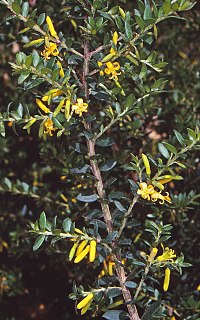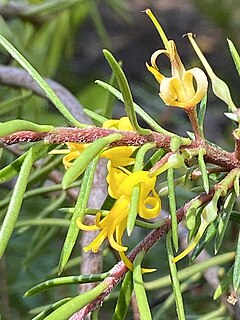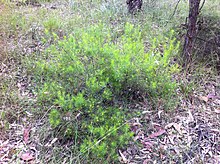Persoonia micranthera, commonly known as the small-flowered snottygobble, is a species of flowering plant in the family Proteaceae and is endemic to a restricted area in the south-west of Western Australia. It is a low-lying to prostrate shrub with branchlets that are hairy when young, spatula-shaped to lance-shaped leaves with the narrower end towards the base, hairy yellow flowers borne in groups of four to fifteen, and smooth, oval fruit.

Persoonia myrtilloides, commonly known as myrtle geebung, is a plant in the family Proteaceae and is endemic to New South Wales. It is an erect to spreading shrub with elliptic to egg-shaped leaves and yellow flowers in groups of up to forty on a rachis up to 170 mm (6.7 in) long.

Persoonia glaucescens, commonly known as the Mittagong geebung, is a species of flowering plant in the family Proteaceae and is endemic to New South Wales. It is an erect shrub with smooth bark, hairy young branchlets, lance-shaped leaves with the narrower end towards the base, and yellow flowers. It is the only persoonia in eastern Australia with strongly glaucous leaves.
Persoonia katerae is a plant in the family Proteaceae and is endemic to a small area on the coast of New South Wales. It is an erect shrub to small tree with smooth bark on the branches, narrow elliptic to lance-shaped leaves with the narrower end towards the base, and yellow flowers in groups of six to twenty-two on a rachis 30–160 mm (1.2–6.3 in) long.

Persoonia procumbens is a plant in the family Proteaceae and is endemic to part of the New England Tableland. It is a prostrate shrub with rather fleshy, relatively large leaves and small groups of cylindrical yellow flowers. It is similar to P. daphnoides but has darker hairs on the young branches and smaller, less hairy flowers.

Persoonia bargoensis, commonly known as the Bargo geebung, is a species of flowering plant in the family Proteaceae and is endemic to a restricted area of New South Wales. It is an erect shrub with linear to lance-shaped leaves, yellow, tube-shaped flowers and green, pear-shaped fruit.

Persoonia asperula, commonly known as mountain geebung, is a plant in the family Proteaceae and is endemic to south-eastern Australia. It is an erect or prostrate shrub with smooth bark, mostly elliptic to oblong leaves and yellow flowers borne singly or in groups of up to nine. It mostly occurs in the Southern Highlands of New South Wales. A small population in Victoria may be a different species.
Persoonia pertinax is a species of flowering plant in the family Proteaceae and is endemic to Western Australia. It is an erect to spreading shrub with hairy young branchlets, twisted linear leaves, and hairy yellow flowers borne in groups of up to ten on a rachis up to 60 mm (2.4 in) long.

Persoonia isophylla is a plant in the family Proteaceae and is endemic to New South Wales. It is an erect or spreading shrub with soft, pine-like leaves and groups of cylindrical yellow flowers. It is similar to P. pinifolia but the flowers of that species have small leaves at their base, where the flowers of P. isophylla have full-sized leaves at their base. The two species sometimes grow together but hybrids between them are rare.

Persoonia conjuncta is a species of flowering plant in the family Lamiaceae and is endemic to eastern New South Wales. It is an erect shrub or small tree with narrow elliptic to lance-shaped leaves, yellow, tube-shaped flowers in groups of up to sixteen and green fruit.

Persoonia oleoides is a species of flowering plant in the family Proteaceae and is endemic to north-eastern New South Wales. It is an erect to low-lying shrub with oblong to egg-shaped leaves and yellow flowers in groups of up to twenty-five on a rachis up to 130 mm (5.1 in) long.

Persoonia cuspidifera is a species of flowering plant in the family Proteaceae and is endemic to northern New South Wales. It is an erect shrub with spatula-shaped leaves and greenish yellow, tube-shaped flowers in groups of up to twenty-five.
Persoonia bowgada is a species of flowering plant in the family Proteaceae and is endemic to the south-west of Western Australia. It is an erect to spreading shrub with smooth bark, more or less cylindrical leaves and yellow flowers in groups of up to ten on the ends of branches.

Persoonia brevifolia is a plant in the family Proteaceae and is endemic to a restricted area near the border between south-eastern New South Wales and Victoria. It is an erect shrub with elliptic to egg-shaped leaves and cylindrical yellow flowers arranged singly in leaf axils.

Persoonia acuminata is a plant in the family Proteaceae and is endemic to New South Wales. It is a spreading or prostrate shrub with relatively small leaves and cylindrical yellow flowers arranged singly or in groups of up to sixteen in leaf axils or on the ends of the branches. It grows in moist forest on the higher parts of the tablelands.

Persoonia rufa is a species of flowering plant in the family Proteaceae and is endemic to the a restricted area of New South Wales. It is an erect to spreading shrub with hairy young branchlets, elliptic leaves, and yellow flowers borne in groups of up to twelve on a rachis up to 110 mm (4.3 in), each flower with a leaf at its base.
Persoonia volcanica is a species of flowering plant in the family Proteaceae and is endemic to eastern Australia. It is an erect shrub with hairy young branchlets, egg-shaped to oblong leaves, and yellow flowers borne in groups of up to twenty on a rachis up to 180 mm (7.1 in) that usually continues to grow after flowering, each flower with a leaf at its base.
Persoonia biglandulosa is a species of flowering plant in the family Proteaceae and is endemic to the south-west of Western Australia. It is an erect, spreading or low-lying shrub with smooth bark, linear leaves and bright yellow flowers in groups of between eight and twenty-five on the ends of branches.
Persoonia kararae is a species of flowering plant in the family Proteaceae and is endemic to the Perenjori district of Western Australia. It is an erect, spreading shrub with densely hairy branchlets, linear leaves and yellow flowers in goups of up to ten on a rachis up to 10 mm (0.39 in) long.

Persoonia hindii is a plant in the family Proteaceae and is endemic to a small area of New South Wales near Lithgow. It is a shrub with an underground stolon from which new stems arise and has succulent, linear to oblong leaves and deep yellow flowers.















